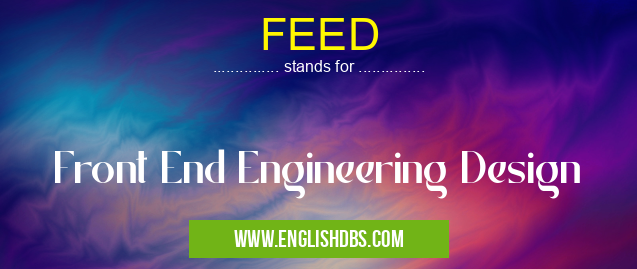What does FEED mean in BUSINESS
FEED stands for Front End Engineering Design, which is an essential stage in the engineering process and one of the most important activities in a project's lifecycle. The FEED phase involves gathering all technical information about the project and then producing a comprehensive engineering design that will satisfy both safety and operational requirements, as well ensure efficient production. It’s essentially a stage-gate process – it facilitates decision-making throughout the life of a project.

FEED meaning in Business in Business
FEED mostly used in an acronym Business in Category Business that means Front End Engineering Design
Shorthand: FEED,
Full Form: Front End Engineering Design
For more information of "Front End Engineering Design", see the section below.
Definition
At its core, FEED is an engineering design process that enables companies to move forward with confidence when making decisions related to their projects. It defines the scope of work before detailed design begins, and its purpose is to provide an accurate representation of what needs to be done in terms of designing and constructing a project. This includes determining how much it will cost, as well as assessing the risks involved in developing it. The FEED phase also establishes guidelines for construction timelines so that teams can better manage cost control and maintain quality standards throughout the entire project’s duration. In more technical terms, this is known as “front end loading” (FEL) – using available resources efficiently by investing more heavily at the beginning of a project or venture prior to full implementation.
Advantages
The advantages of the FEED process are numerous; here are just a few: • Reduced Risk - By gathering all required information upfront, FEED helps reduce risk associated with potential delays or costly rework later on in the project development timeline. It provides an accurate assessment on how much money needs to be allocated for each activity while providing greater control over spending costs; • Improved Planning - Having access to reliable figures within the planning stages ensures better decision-making during critical times; • Accurate Scheduling - Having everything planned out ahead of time prevents delays from unexpected issues or possible information gaps; • Enhanced Quality Assurance - With an established blueprint detailing all expectations up front, there is less room for error or miscalculations once actual construction begins; • Reduced Rework - Due diligence early on helps prevent oversights later down the road which could ultimately result in expensive rework costs – something no company wants to pay for twice!
Essential Questions and Answers on Front End Engineering Design in "BUSINESS»BUSINESS"
What is Front End Engineering Design (FEED)?
FEED stands for Front End Engineering Design. It is an engineering stage in the development of a large project that includes the preparation of a complete design package, including documents and drawings, which can be used to obtain bids and construction contracts for the project.
How does FEED fit into the overall development of a large project?
FEED is an important step in setting up the framework for project development as it helps refine project scope, determine technical requirements, define interfaces between different systems, formulate cost estimates with greater accuracy, and meet regulatory requirements.
What type of documents and drawings are included in an FEED package?
An FEED package may include P&IDs (Piping and Instrumentation Diagrams), process flow diagrams, process control strategies, equipment specifications, instrument data sheets, instrument diagrams and electrical wiring diagrams.
Who typically reviews an FEED package?
The review team usually consists of engineers from various disciplines such as mechanical engineering, electrical engineering, process engineering etc., who assess the quality of design documents and ensure compliance with standards.
What are some benefits of conducting a FEED prior to starting construction?
Some key benefits include early identification of potential delays or problems in order to reduce overall costs & timeframes; improved communication between contractors & other stakeholders; enhanced safety by reducing risk potentials; improved plant reliability & performance; and accurate cost estimates for budgeting purposes.
Does deciding to move forward with FEED commit me to a certain design?
No – committing to proceeding with FEED does not automatically commit you to any particular design solution or implementation method. Rather it begins the detailed process that enables you to refine your plan over time before making any binding decisions about implementation methods.
How long does a typical Front End Engineering Design take?
It depends on the complexity of the project but generally most projects take 6-9 months from start to finish. This includes initial planning & approval stages as well as detailed design followed by commissioning & completion stages depending on project requirements.
Does conducting an FEED guarantee success for a large project?
While conducting an FEED will help provide essential guidance during a project's development lifecycle by controlling costs & optimizing resources for improved performance, there are no guarantees that all aspects will be successful due to factors such as changes in market conditions or unforeseen challenges along the way.
Is there any way to reduce risks associated with developing a large project after an FEED has been completed?
Yes - engaging experienced professionals throughout each phase can help manage risks associated with developing large projects. Regular reviews should also me conducted during all stages of implementation to ensure that objectives continue through successful completion.
Final Words:
Regardless of what kind of project you’re embarking on, having a clearly defined engineering design through FEED can help reduce costs and optimize efficiency during development phases while ensuring minimal risk associated with any potential issues down the line. Ultimately, its purpose is to provide assurance that short-term goals will properly lead into long-term objectives without any unforeseen hurdles blocking progress along the way. So if you’re looking to make sure your next capital investments are met with success, you should consider implementing some form of Front End Engineering Design before taking off!
